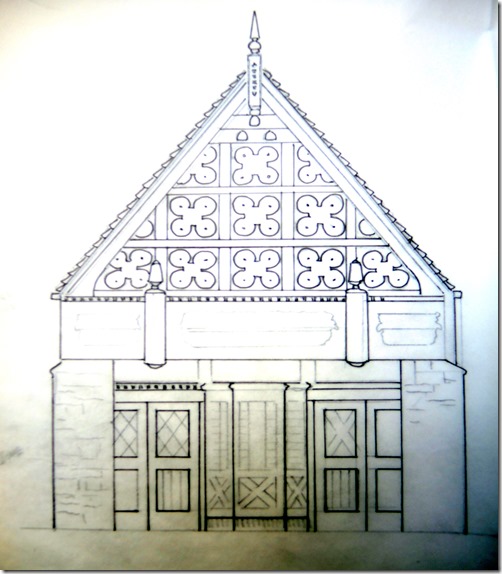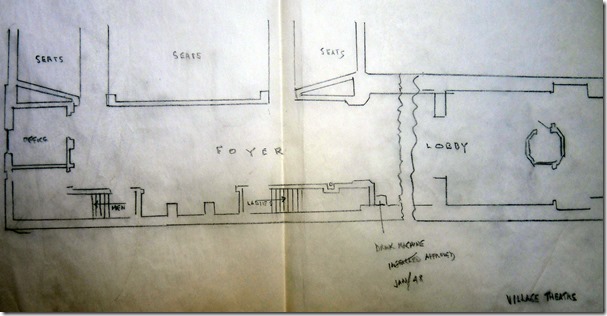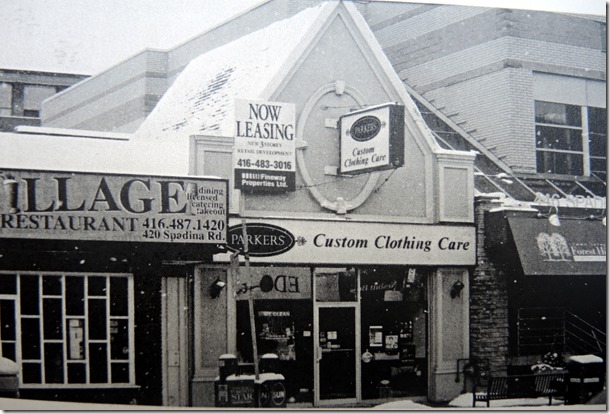The Village Theatre at 418 Spadina Road in Forest Hill Village (Spadina Village) was a gem in the heart of a small business community that truly created the atmosphere of a small town. In past decades it was referred to as Lower Forest Hill Village and centred on Spadina Road and Lonsdale Avenue. E. M. Farquharson, in an article in the Canadian Home Journal, referred to the Village Theatre as “a neighbourhood cinema in a district of lovely homes.”
Plans for the theatre were submitted to the City of Toronto in November of 1935, at the height of the Great Depression. The architect was Herbert Duerr (1891-1966), who designed the Hollywood Theatre and the Major Rogers Road Theatre (Rogers Road and Silverthorne Avenue). Born in Pittsburgh, he caught the attention of Famous Players and became the corporation’s favourite architect. He designed many theatres across Canada and the United States.
This sketch of the Village Theatre is from the Toronto Archives.
I was unable to locate any photos of the Village Theatre in the City of Toronto Archives or the Ontario Archives. However, of all the local theatres I have researched, judging by the sketch that has survived, it was architecturally one of the most unusual. It resembled a quaint shop or house that one might see in an Alpine village, its small peaked roof and unpretentious marquee adding to its quaintness.
The theatre’s box office was in a central position at the front of the structure, and extended from the facade toward the sidewalk. Double doors on either side of it gave access to the outer lobby, which was aligned east-west. Another set of doors opened onto the inner lobby. Because the theatre’s frontage was narrow, the lobby extended a considerable distance from the street. A drink machine that dispensed carbonated beverages was tucked into an alcove in the inner lobby. The auditorium was aligned north-south, with separate doors leading to the aisles.
Diagram of the interior of the Village Theatre. City of Toronto Archives.
For many years, the manager of the theatre was Miss Evelyn Lilly. A pioneer in the industry, she was the first woman manager hired by Famous Players Corporation. A petit blonde woman, she was less than five feet in height, but possessed a forceful personality. During the years that she managed the theatre, she knew all the local theatregoers and was able to address most of them by name. In 1924, Miss Lilly had commenced her career as a cashier at the Kingswood Theatre, located at 922 Kingston Road, near Kingswood and Kingston Roads. She worked part time at the Kingswood—a few hours on weeknights and Saturday afternoons, for six dollars a week.
Patrons said that she added a woman’s touch at the Village Theatre. After every show, she opened the rear doors to air out the he auditorium. During the war years, she avoided screening war movies as she felt that women were too mindful of the real events taking place overseas to want to witness the conflict on screen. After the war, she became an advocate for more women managers.
After the theatre closed, the building was renovated and contained a dry cleaners. Eventually, the dry cleaners and the restaurant next to it were demolished to construct a boxy two-story building that contained an LCBO on the ground floor.
This undated photo in the City of Toronto Archives shows the site of the Village Theatre after it became a dry cleaners.
To view the Home Page for this blog: https://tayloronhistory.com/
To view previous blogs about movie houses of Toronto—historic and modern
A link to view posts that explore Toronto’s Heritage Buildings:
https://tayloronhistory.com/2014/01/02/canadas-cultural-scenetorontos-architectural-heritage/
Recent publication entitled “Toronto’s Theatres and the Golden Age of the Silver Screen,” by the author of this blog. The publication explores 50 of Toronto’s old theatres and contains over 80 archival photographs of the facades, marquees and interiors of the theatres. It relates anecdotes and stories of the author and others who experienced these grand old movie houses.
To place an order for this book:
Book also available in Chapter/Indigo, the Bell Lightbox Book Store and by phoning University of Toronto Press, Distribution: 416-667-7791
Book also available in Chapter/Indigo, the Bell Lightbox Book Shop, and by phoning University of Toronto Press, Distribution: 416-667-7791 (ISBN 978.1.62619.450.2)
Another book, published by Dundurn Press, containing 80 of Toronto’s old movie theatres will be released in the spring of 2016. It is entitled, “Toronto’s Movie Theatres of Yesteryear—Brought Back to Thrill You Again.” It contains over 130 archival photographs.
A second publication, “Toronto Then and Now,” published by Pavilion Press (London, England) explores 75 of the city’s heritage sites. This book will also be released in the spring of 2016.



![cid_E474E4F9-11FC-42C9-AAAD-1B66D852[1] cid_E474E4F9-11FC-42C9-AAAD-1B66D852[1]](https://tayloronhistory.com/wp-content/uploads/2015/04/cid_e474e4f9-11fc-42c9-aaad-1b66d8521_thumb2.jpg)

